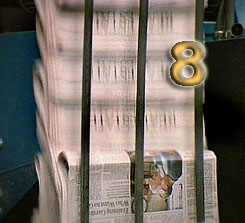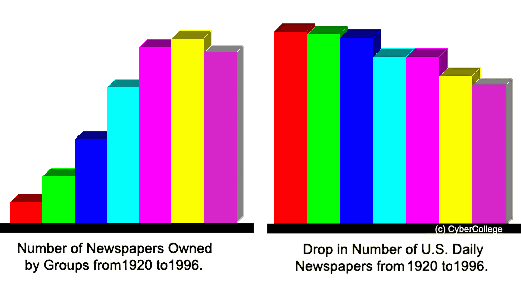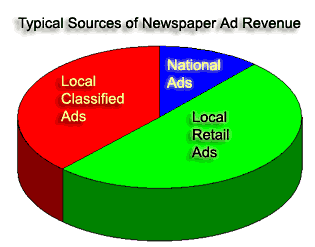The Print Media - 8-A |
|
Newspapers Today
As in the case of books, newspapers are now owned in large measure by conglomerates (large corporations that have numerous, and often diverse business interests). Many U.S. media conglomerates are owned by corporations outside of the U.S. Those who favor conglomeration say that it can strengthen the operations of companies involved. For example, by combining news operations, a newspaper that also acquires a TV or radio station (or both) can use a single newsroom and team of reporters to provide news for all of the owned news outlets. If one of the media outlets had a weak news department, this can bolster their operations. Thus, to some degree news operations can be improved while reducing the total number of employees involved. Since "personnel" represents the most expensive operating cost, corporate shareholders benefit. The problem is that many media corporations focus almost entirely on profit. For employees and consumers there can be significant disadvantages.
There comes a point, of course, when the results of cost-cutting impacts newspaper subscriptions. We've probably all flipped though an unfamiliar newspaper to find that beyond the ads there were only generalized wire copy stories and press releases (self-serving information from various institutions) that had little relevance to the community. Possibly the only local news consisted of poorly written contributions by area stringers (people who, receive money on a per-story basis for covering local events in their spare time).
This graph shows the change in the status of newspapers from 1920 to 1996 (the last year that statistics were available). The group owned newspapers (graph on the left above) range from 20 to a high of 1,200. The number of dailies (graph on the right) range from approximately 2,000 to a low of 1,500. Note the rapid increase in group ownership of newspapers. (The dip in 1996 ownership is due to many daily newspapers closing down.)
Note that most ad revenue comes from local advertisers. This is followed by classified ads. For most newspapers (excluding national newspapers, such as USA Today and the Wall Street Journal) national advertising represents a distant third.
Today's Leading Daily Newspapers In 2004, USA Today reported a circulation of 2.3 million, making it the largest newspaper in the United States. These figures are from the Audit Bureau of Circulation, the agency that monitors newspaper circulation. The Wall Street Journal, which targets businesspeople, came in second in circulation. Each weekday the Wall Street Journal publishes five different editions--three national regional editions, an edition in Europe, and an edition in Asia. In addition, "the Journal" counts almost 686,000 on-line subscribers in its circulation figures. The Los Angeles Times ranks third in U.S. circulation; and the New York Times is only slightly behind. Canada’s most widely read daily newspapers are the Toronto Star, and the national Globe and Mail.
Although not generally considered newspaper, at least in the traditional sense, supermarket tabloids such as The National Enquirer actually exceed all other newspapers in overall circulation. There has been considerable debate as to whether these weekly tabloids should be classified as newspapers, magazines, or something in between. The content of tabloids range from "somewhat believable" to "total fiction." With headlines such as "Two-Headed Woman Marries Two Men," and "Two-Headed Woman Has Baby With Two Heads" (complete with created "photos"), the tabloids strain many people's tolerance for freedom of speech. Countries that try to justify censorship often point to such stories as evidence that government control of newspapers is needed to protect naive audiences from such fiction. At the same time, after losing several multi-million dollar lawsuits, the tabloids have become rather careful about saying anything about a person that could be considered libelous. (They get some people to sign releases allowing them to publish a "created" story about them without worrying about repercussions.) The tabloids have encouraged an aggressive breed of photographers known as paparazzi. These photographers shadow famous people in an effort to get candid and revealing photos. Payment for such photos can range into the thousands of dollars. The public reacted negatively against paparazzi when it was first assumed that Princess Grace's fatal automobile crash in France a few years ago was the result of being chased by paparazzi. However, upon investigation, blame shifted to the driver of her car, the paparazzi were then officially listed only as a contributing cause of her untimely death.
Today, computers control almost every phase of newspaper production. First, wire services such as AP send a constant flow of news via telephone lines and satellite links into the hard drives of newsroom computers. Editors can search on key words to locate needed stories. Once stories are located, they can be pulled up on computer screens to be edited or rewritten as needed. Reporters also write their stories on computers. Today's reporters make extensive use of the Internet for doing research. (Some Reporters also do background research on stories by doing computer searches through the newspaper archives (stored computer files of stories that were previously published in the newspaper). When the stories are finished, they are sent to the editor for review. A reporter can also send stories into the newsroom from "the field" via Computers are also taking over newspaper illustrations. Drawings are routinely created by computers. Most newspaper photographers no longer use film cameras. Digital cameras save considerable time and money. Once taken, the photos are uploaded into a computer for cropping, color balancing, sharpening, etc. Once the digital photos are saved in a file, they can be delivered to the newsroom in person or via modem from a distant location. Complete newspaper pages are now composed (assembled) on a computer screen. Completed newspaper pages can then be printed out full size to make plates for the printing presses. Some newspapers paste up the individual page elements on a page dummy, which is then photographed to make an offset plate for the printing press. The larger newspapers can transmit these pages to cities across a country to regional printing facilities--which is how the New York Times, for example, can be on newsstands in Los Angeles within a few hours of being finished in New York. In the next section we'll summarize major historical developments in a chronological order, and list a few major Internet links. |
|
To next module To
index © 1996 - 2005, All Rights Reserved.
|



 revelations appear on the Internet days or weeks before they appear in newspapers or on TV. One rich source of stories comes from blogs, websites that feature personal journals, news, and information on a wide range of topics.
revelations appear on the Internet days or weeks before they appear in newspapers or on TV. One rich source of stories comes from blogs, websites that feature personal journals, news, and information on a wide range of topics.